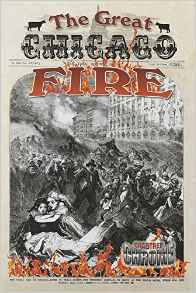| ________________
CM . . .
. Volume XXII Number 37. . . .May 27, 2016
excerpt:
The Great Chicago Fire is part of the nonfiction “Crabtree Chrome” series for children. In this book, the author reconstructs history in an exciting and visually pleasing way. The origins of the fire that left 100,000 people without a home are debated. The timeline of the fire includes details about how and why the fire spread, and, by comparing the city of Chicago in 1871 with the city of Chicago today, the reader will see how the aftermath of such a disaster affected future generations. Photographs show monuments that were built after the fire and buildings that remain standing today. On the bottom of every second page are definitions of words that appear bolded in the paragraphs above (architecture, tragic, conflagration). Incorporated into the vintage-looking paintings and drawings are quotes from witnesses and reporters and labels which identify people and places described in the text (Mrs. O’Leary and her cow, firefighters, the river and bridges). The five chapters are six to ten pages in length. Information is presented with maps, colourized or black and white photographs, and writing that captures the panic of the people and the speed of the fire. By sharing information about Chicago’s origins, children will learn why Chicago grew so fast and how the lumber industry, the layout of the city, and the weather were partially responsible for the spread of the fire. There are small paragraphs that discuss how the mayor ordered martial law to control the looting and crime and how tragedy can bring out the kindness in strangers. Back material lists books and websites for learning more, a glossary which summarizes all the words defined on the bottom of the pages, and a one-page index. The Great Chicago Fire, a fascinating look at a piece of American history, teaches lessons and inspires bravery that can be applicable today no matter where someone lives.
Highly Recommended. Tanya Boudreau is a librarian at the Cold Lake Public Library in Cold Lake, AB.
To comment
on this title or this review, send mail to cm@umanitoba.ca.
Copyright © the Manitoba Library Association. Reproduction for personal
use is permitted only if this copyright notice is maintained. Any
other reproduction is prohibited without permission.
Next Review |
Table of Contents for This Issue
- May 27, 2016. |
